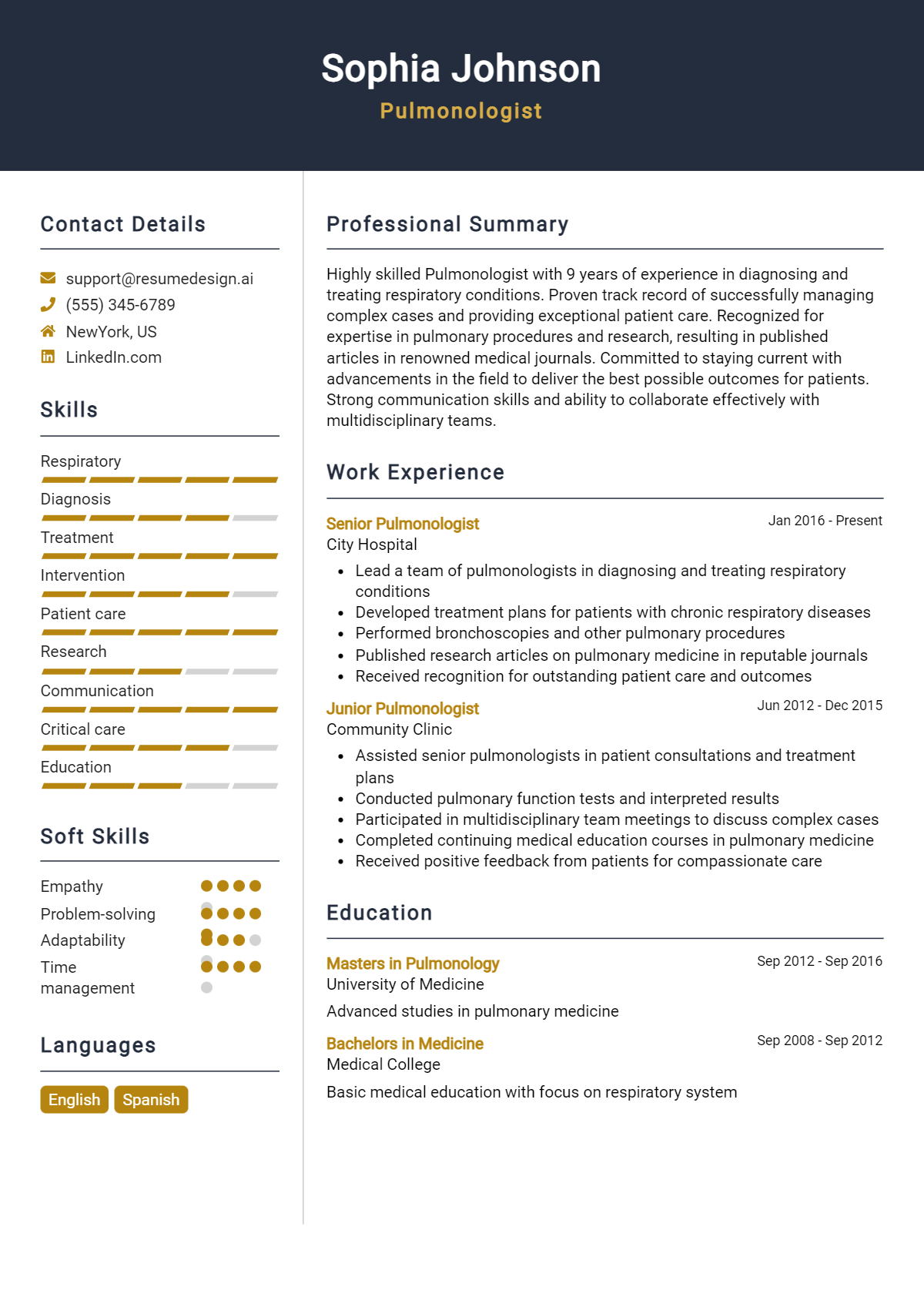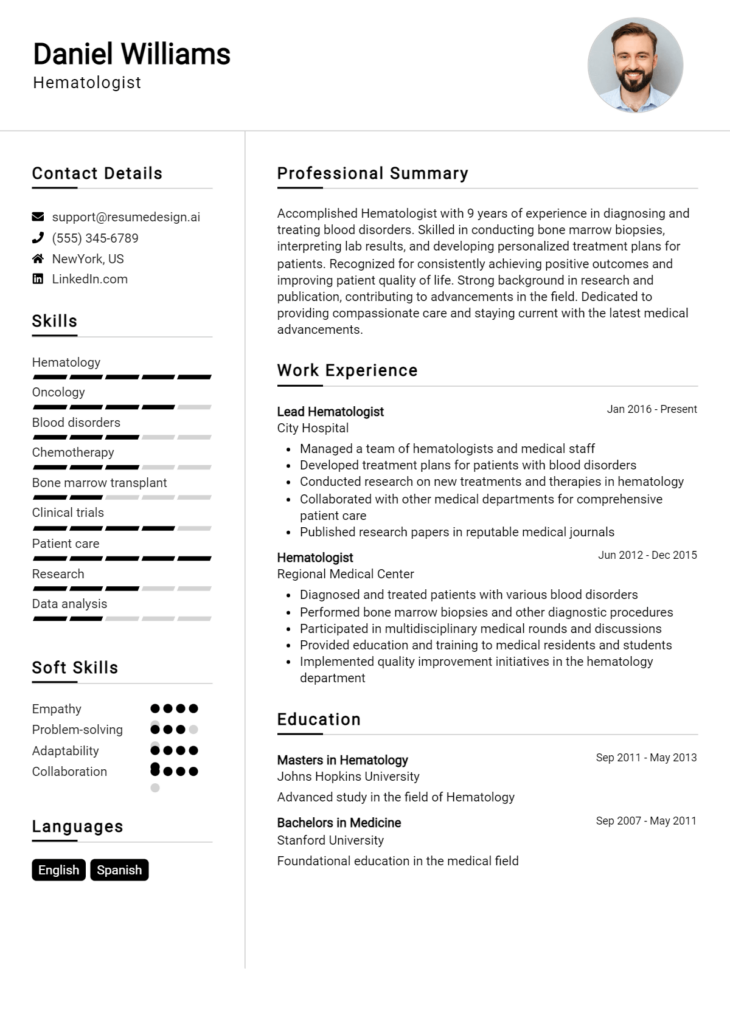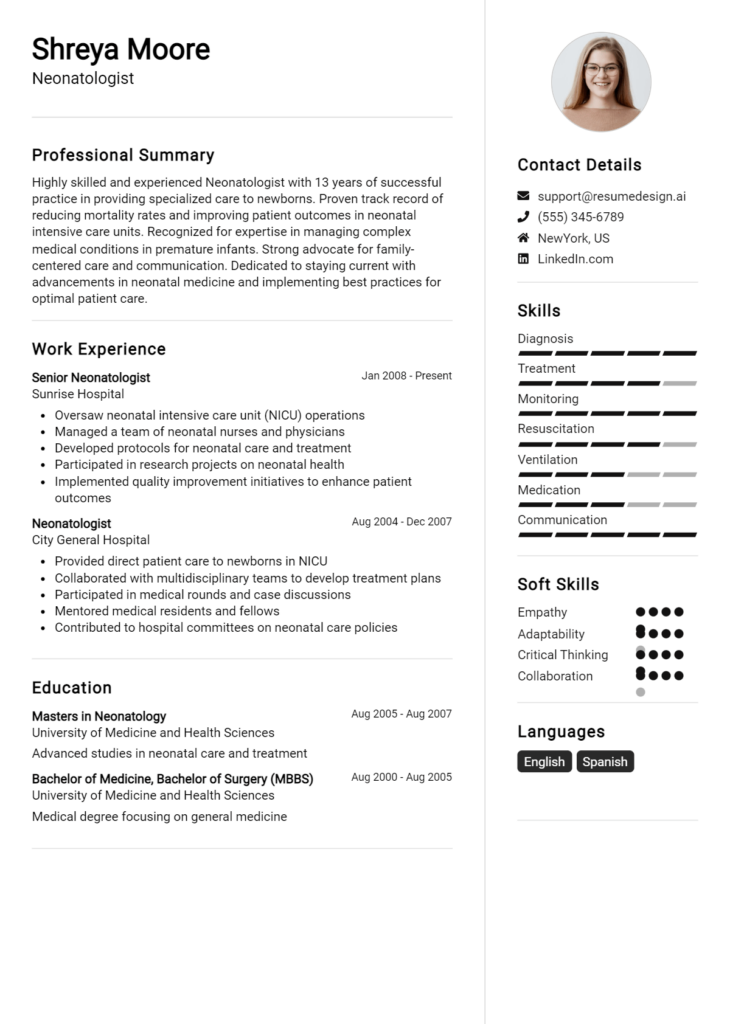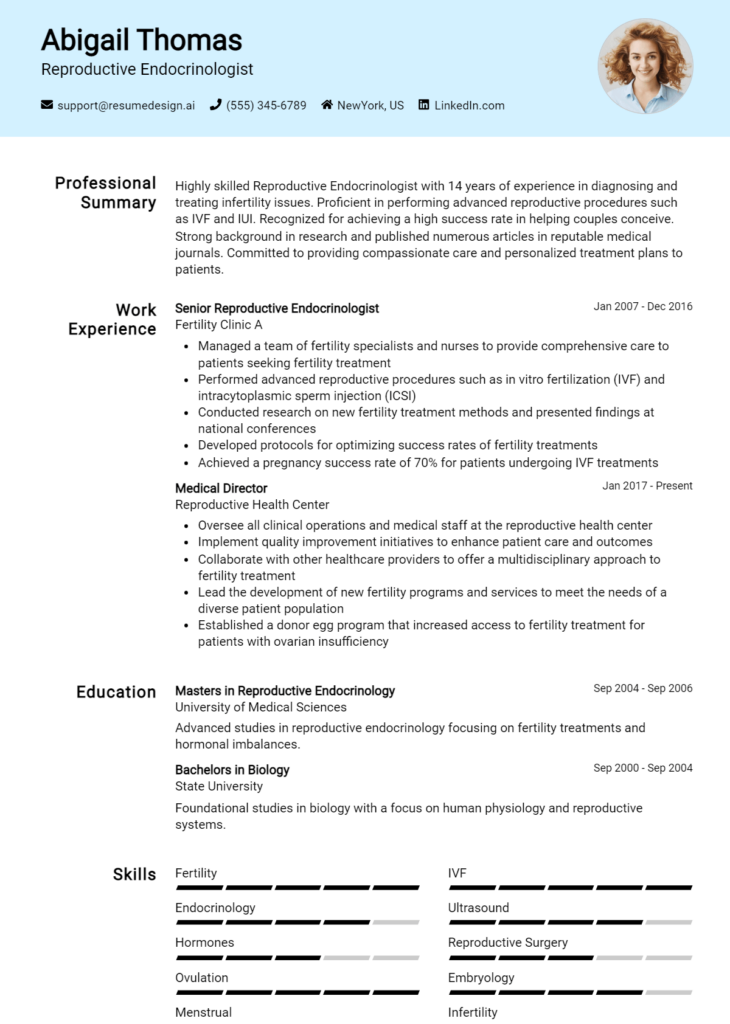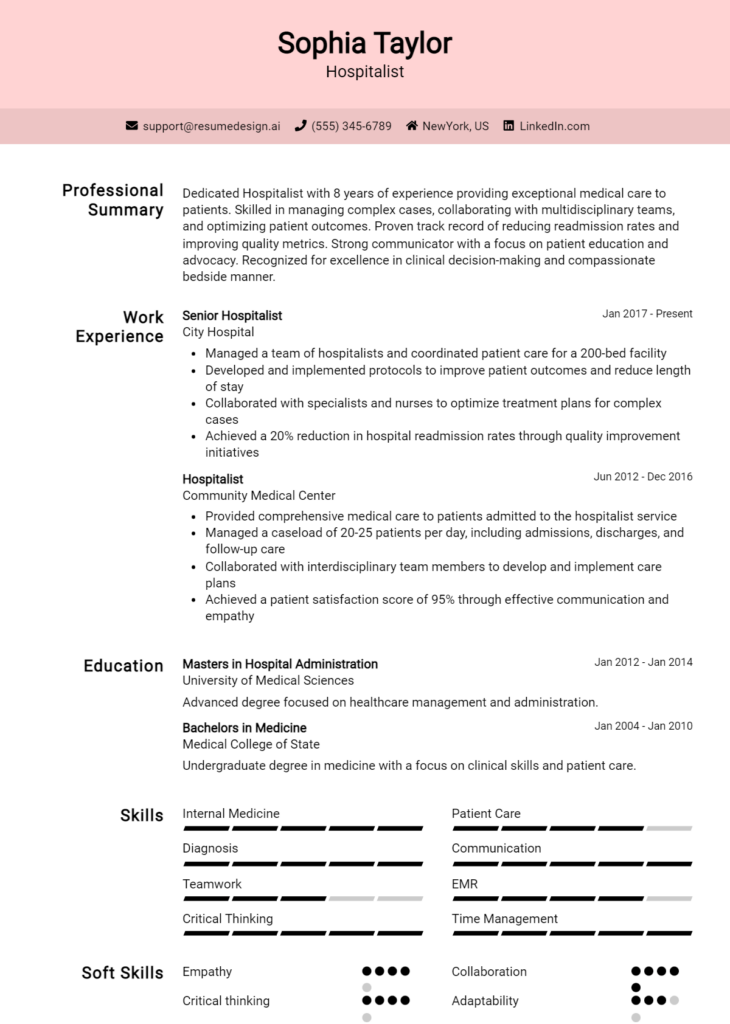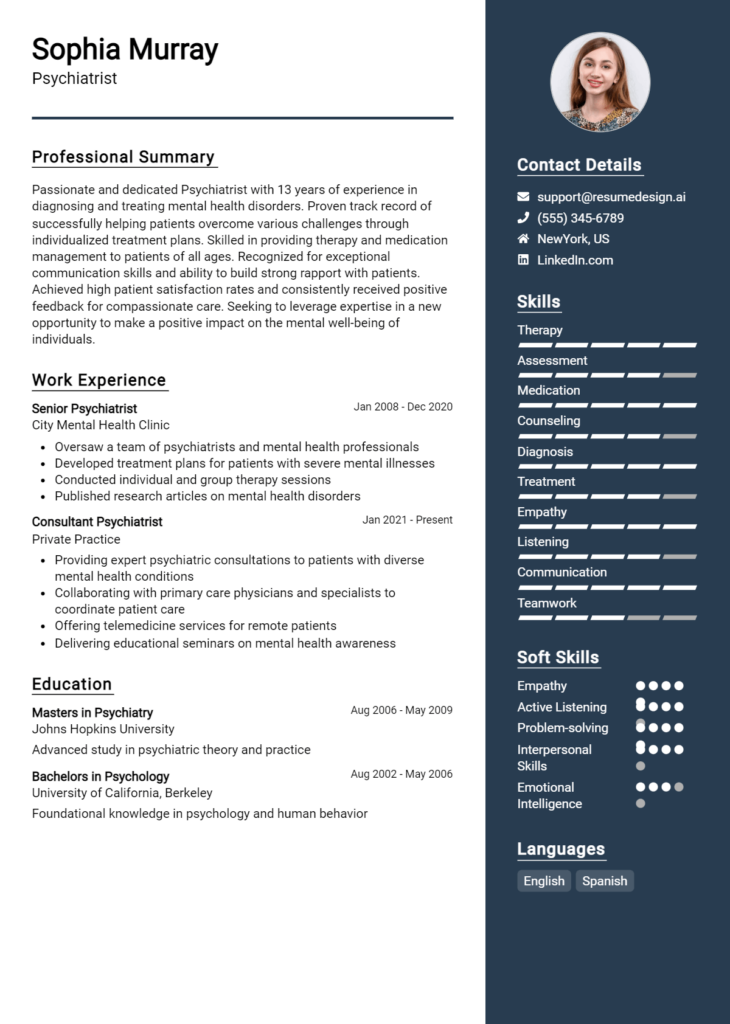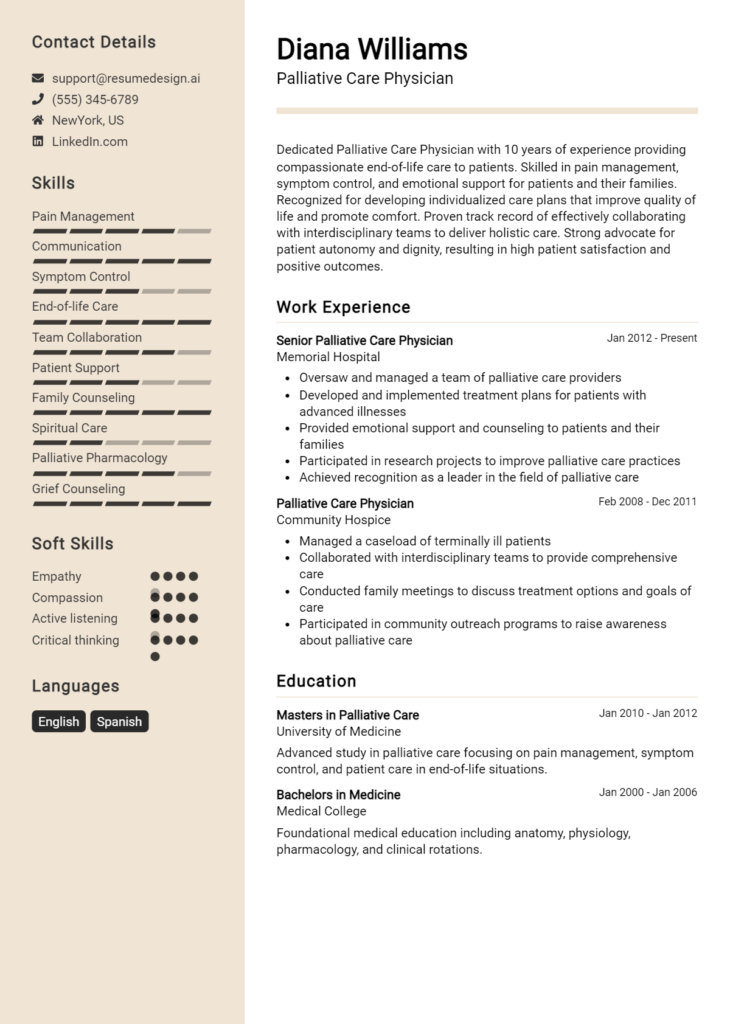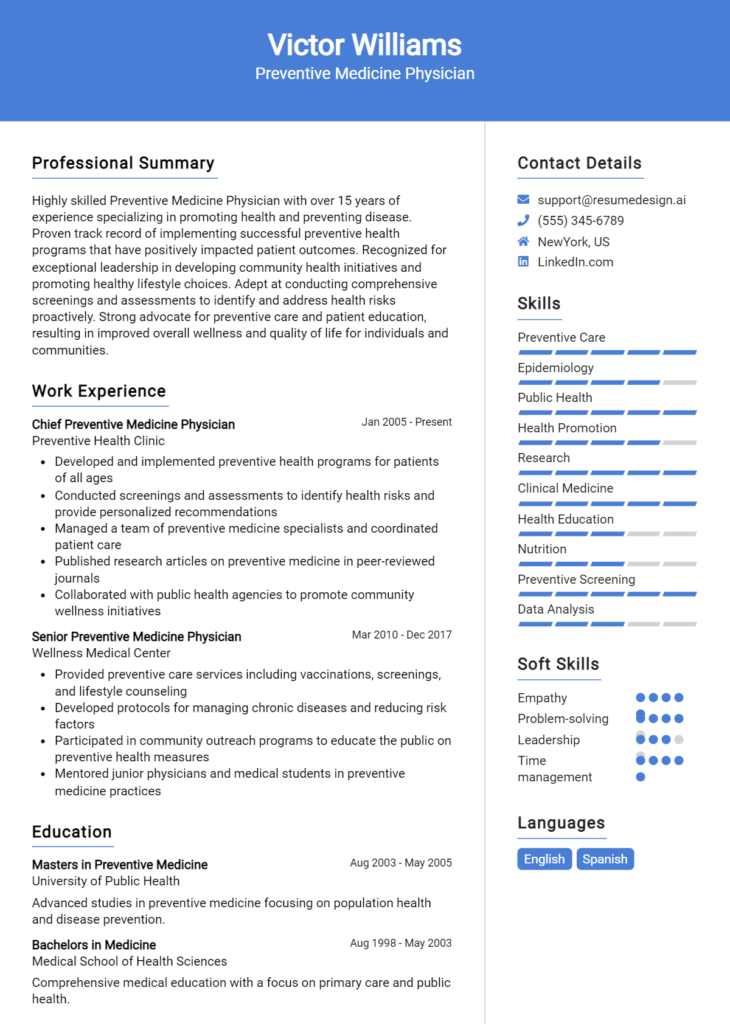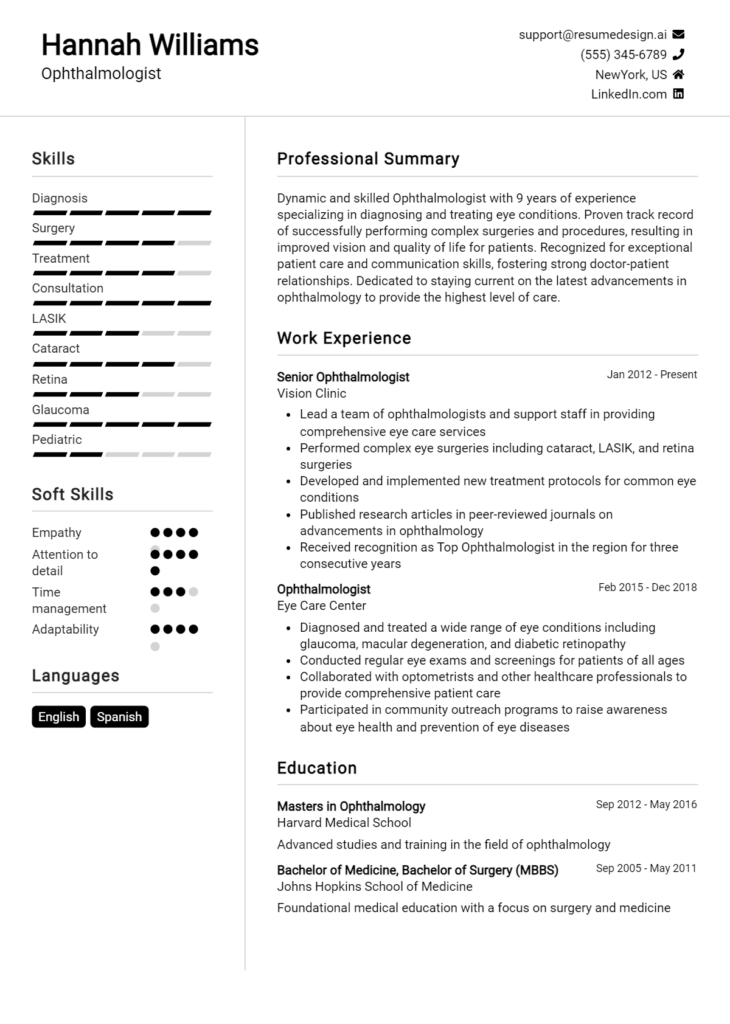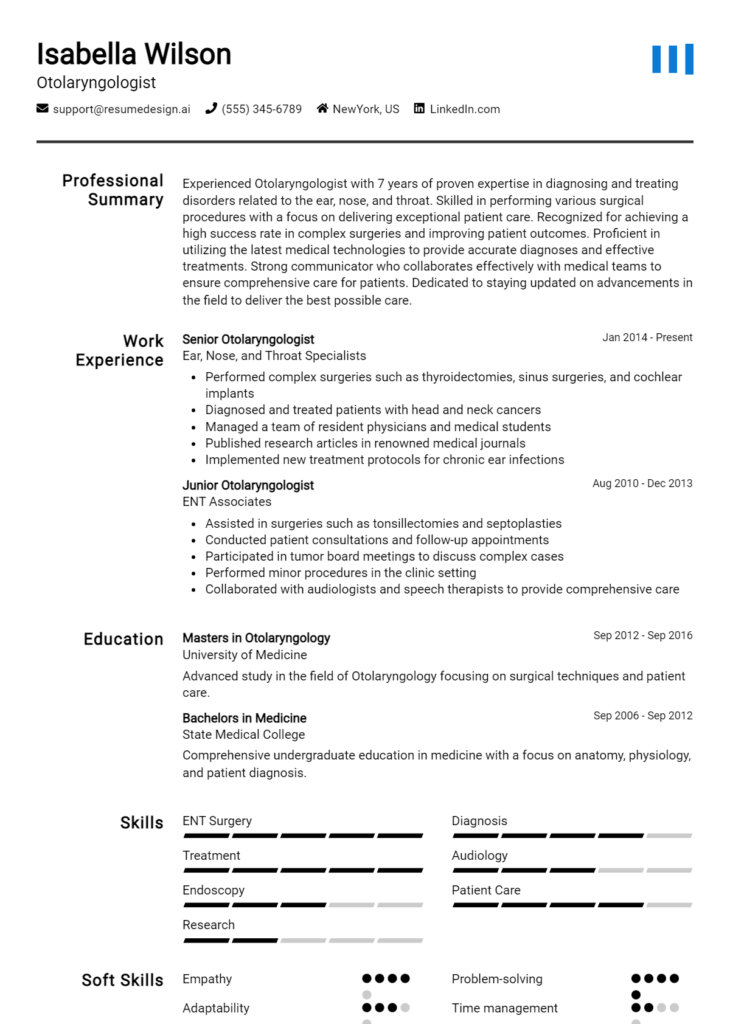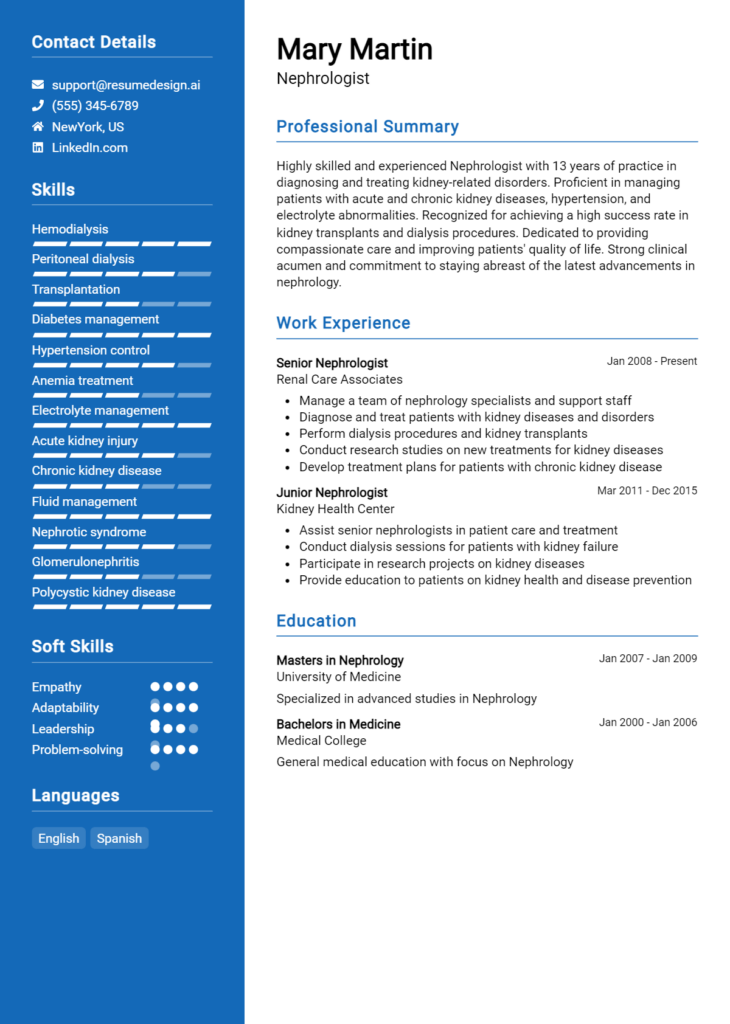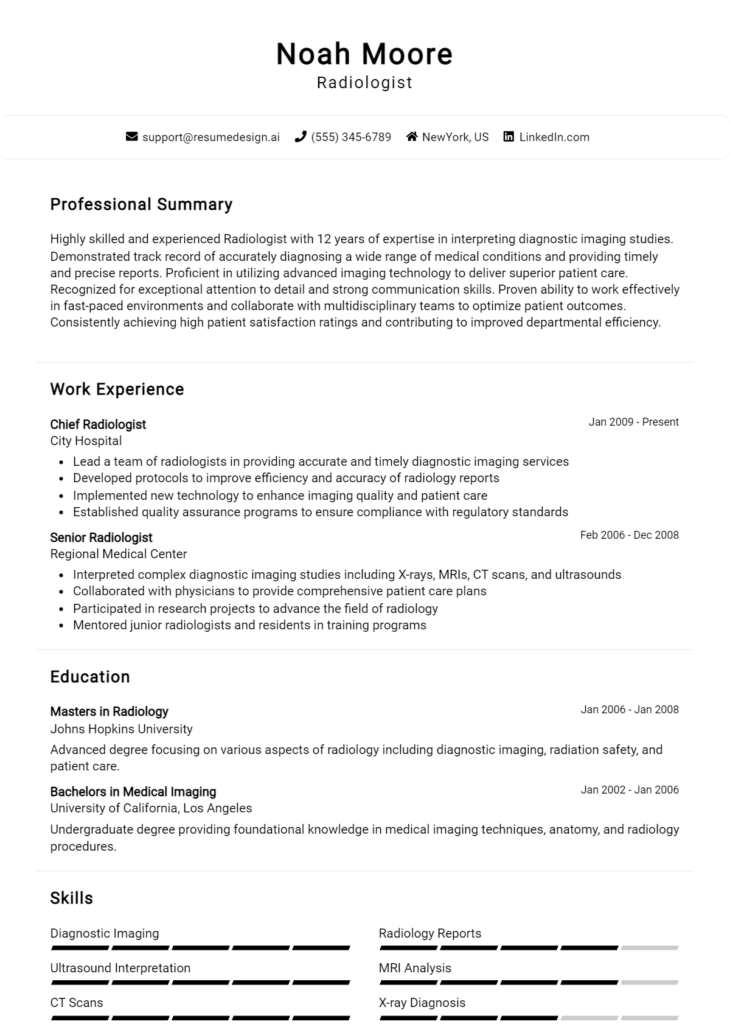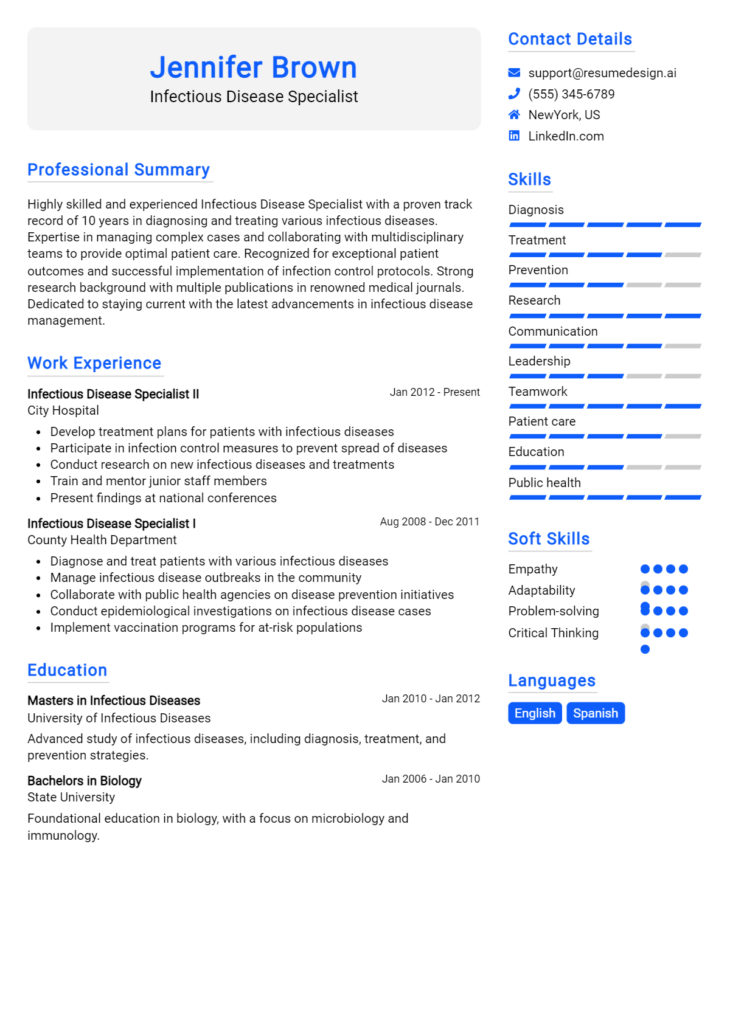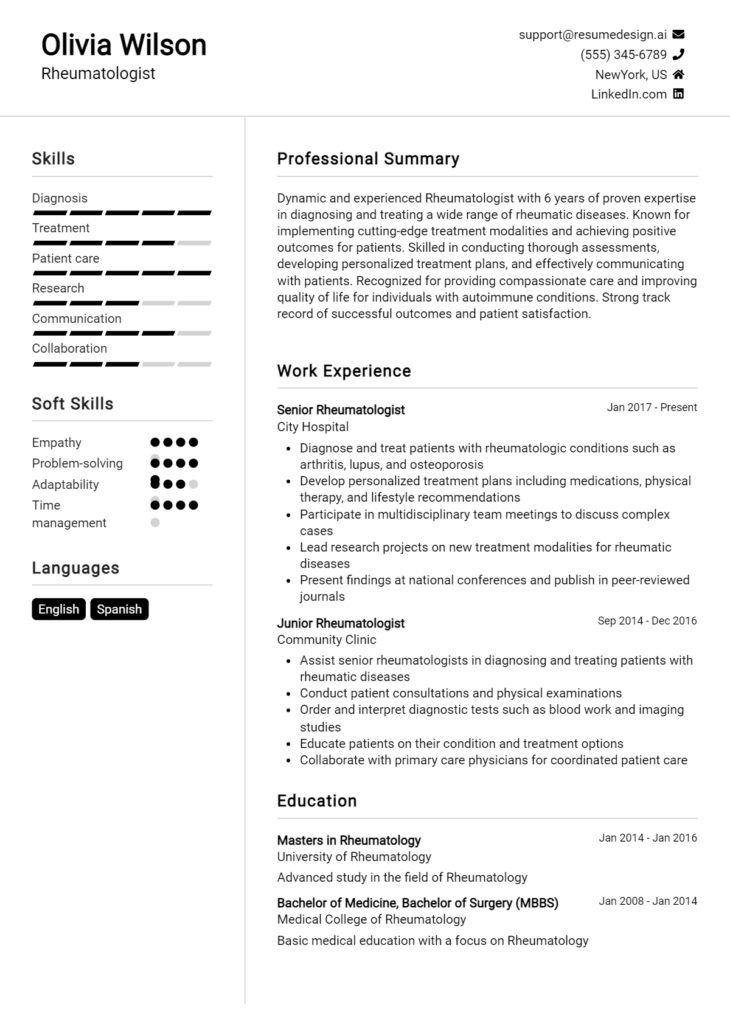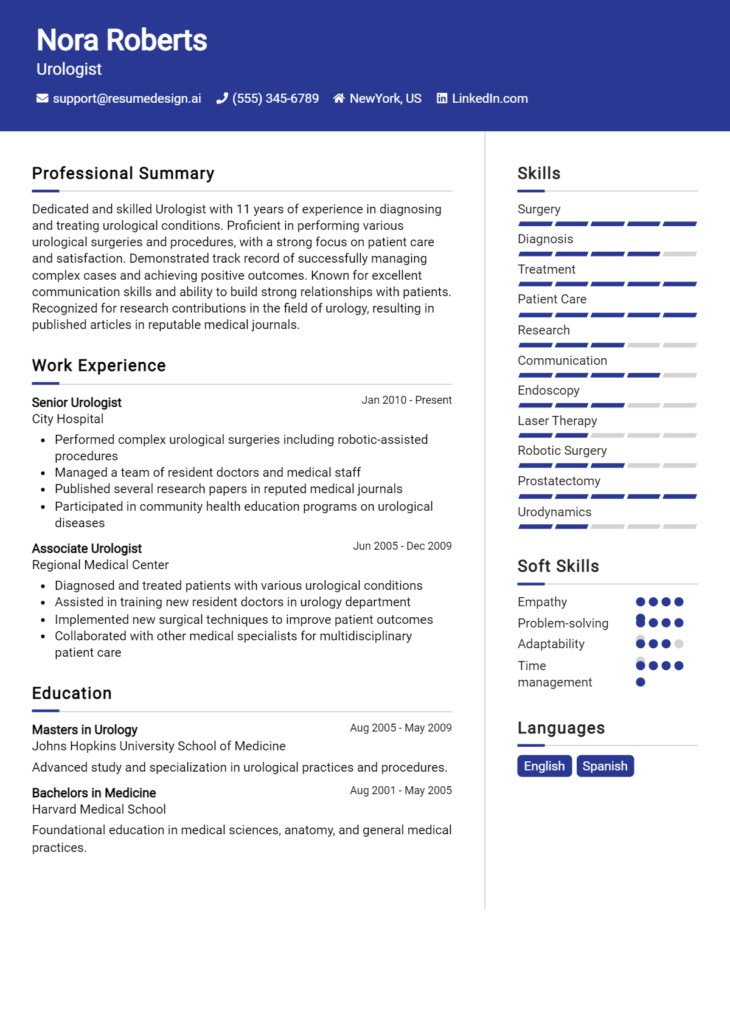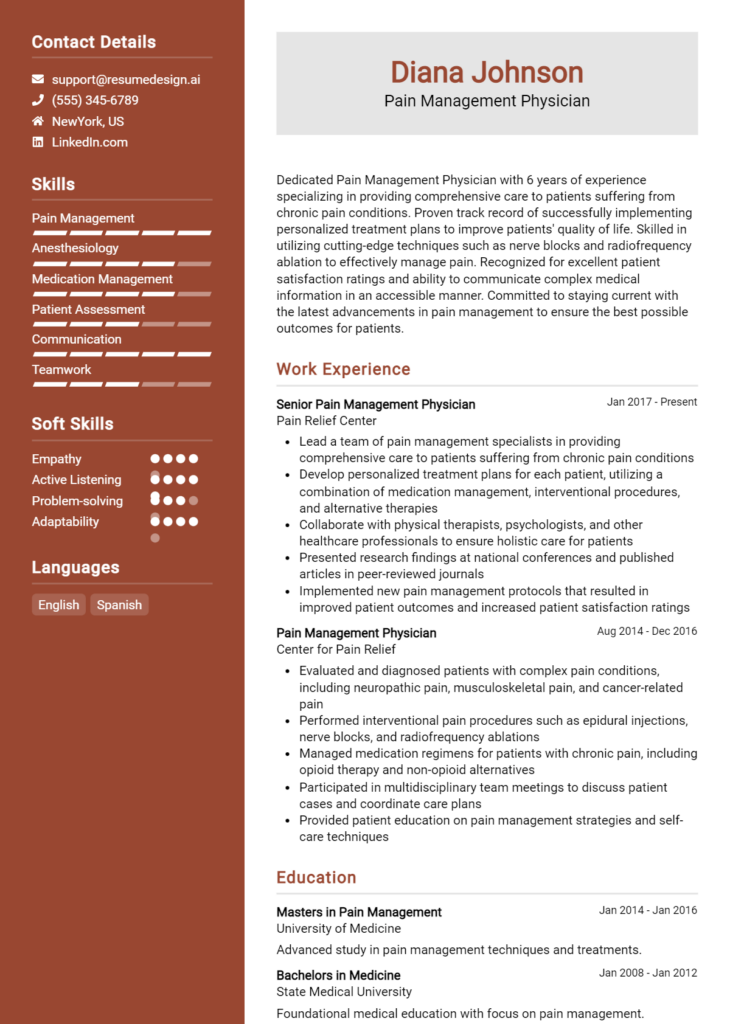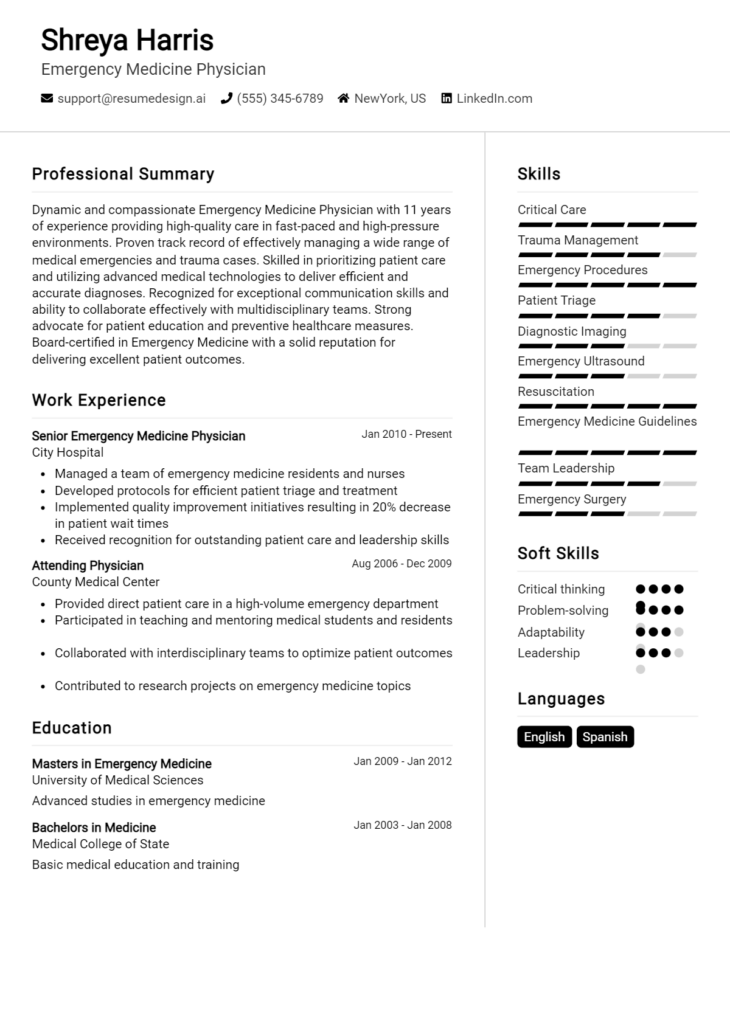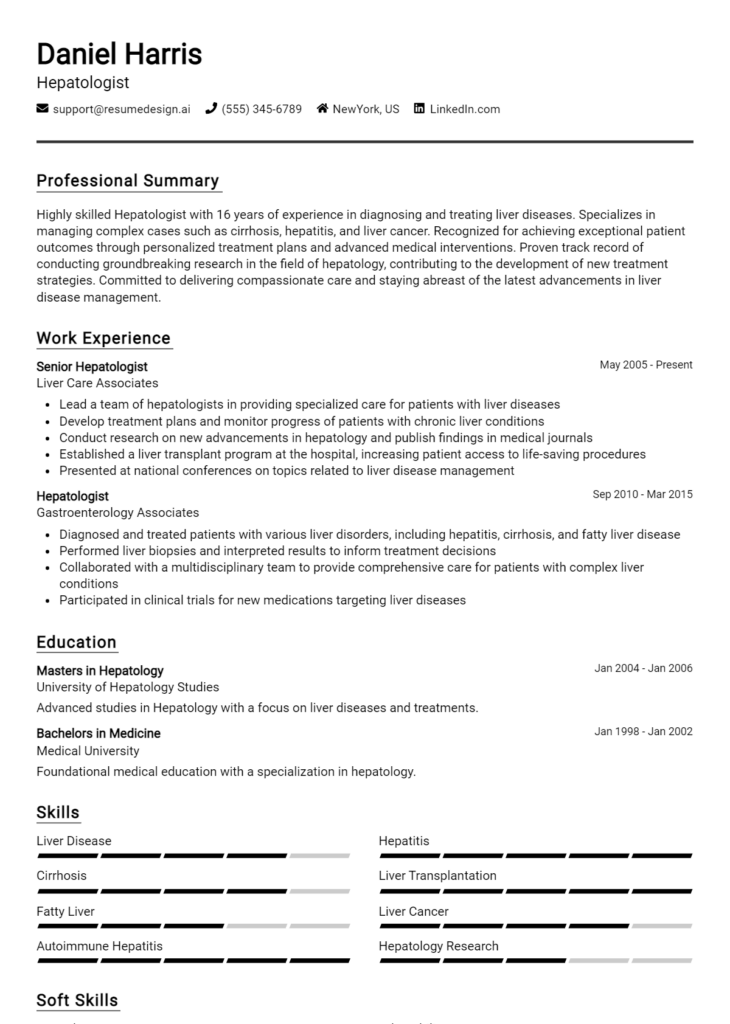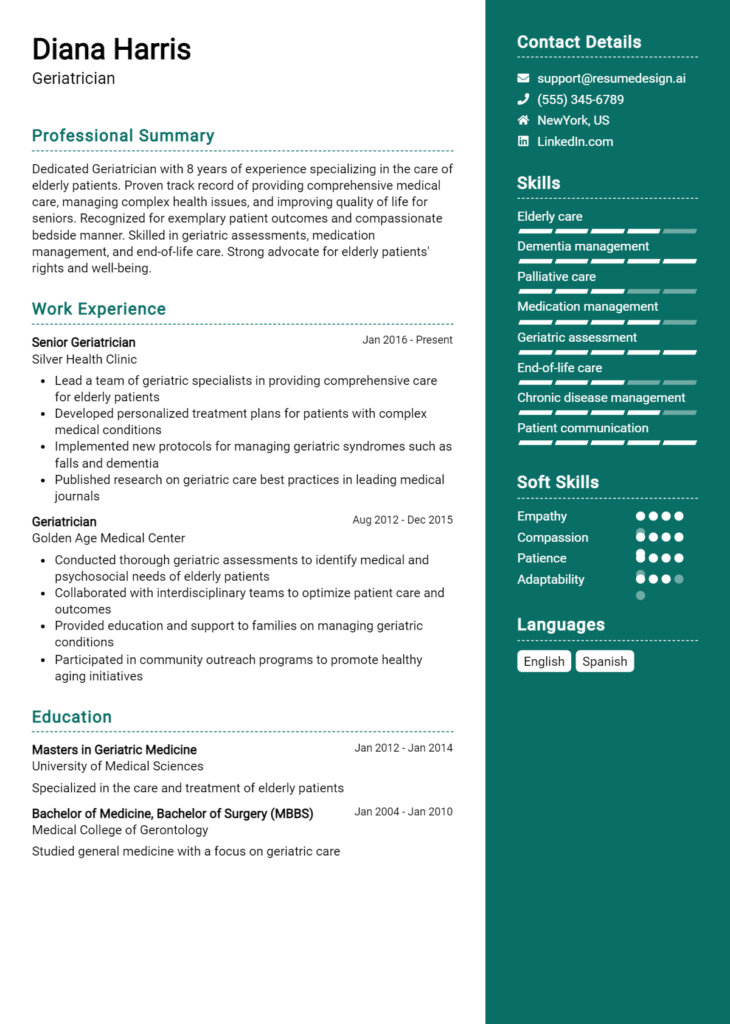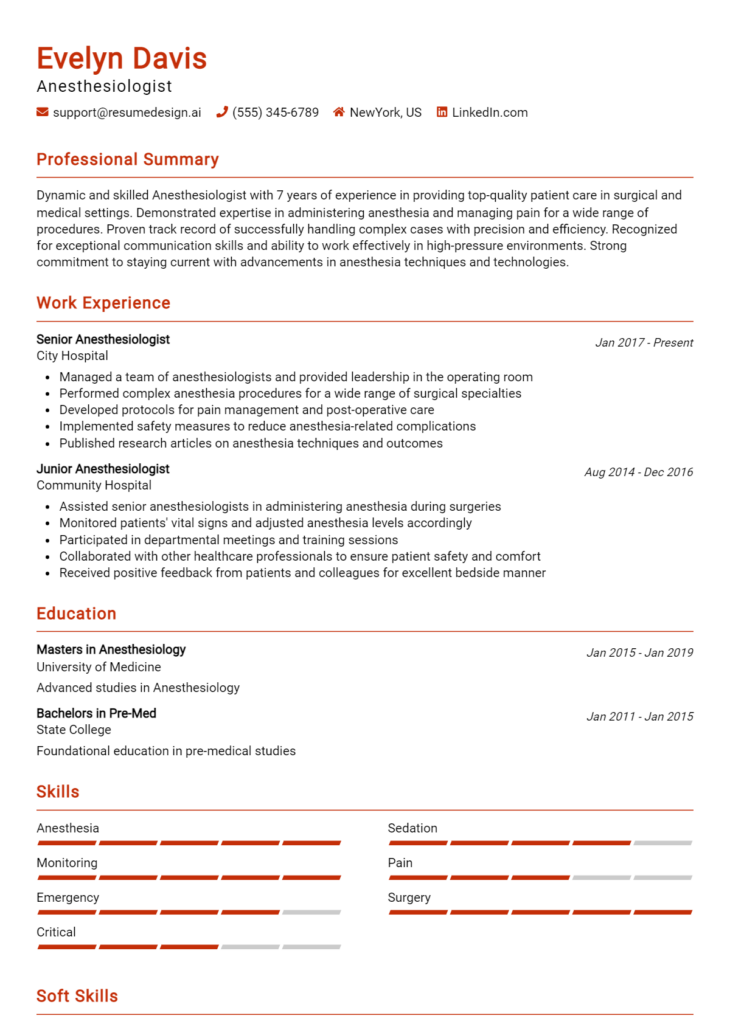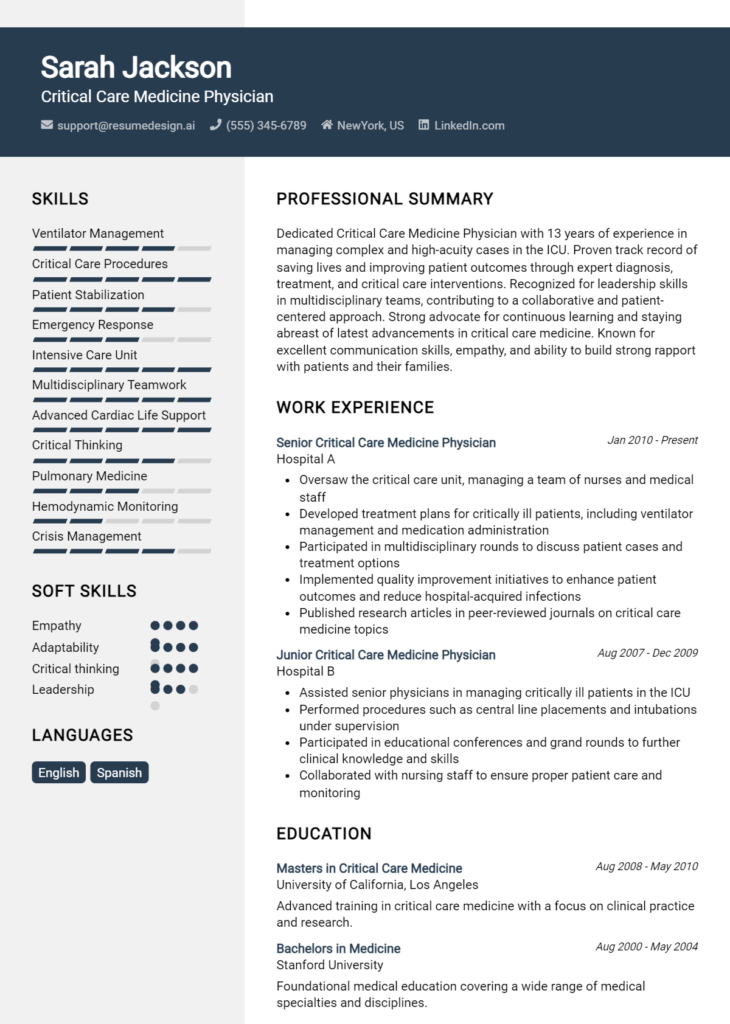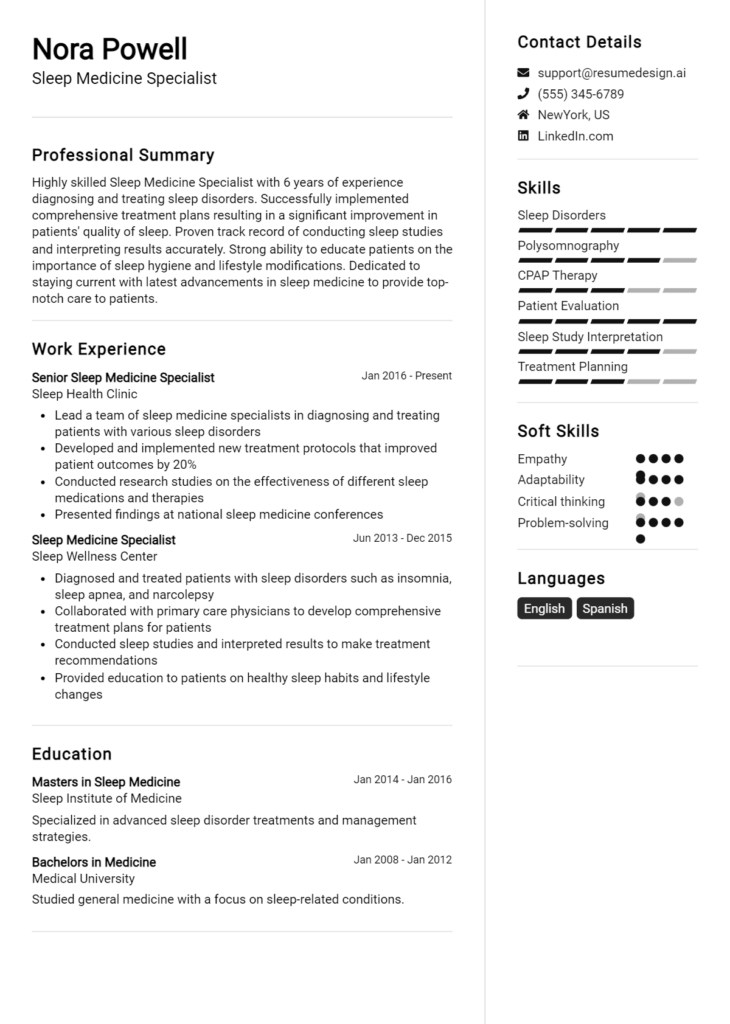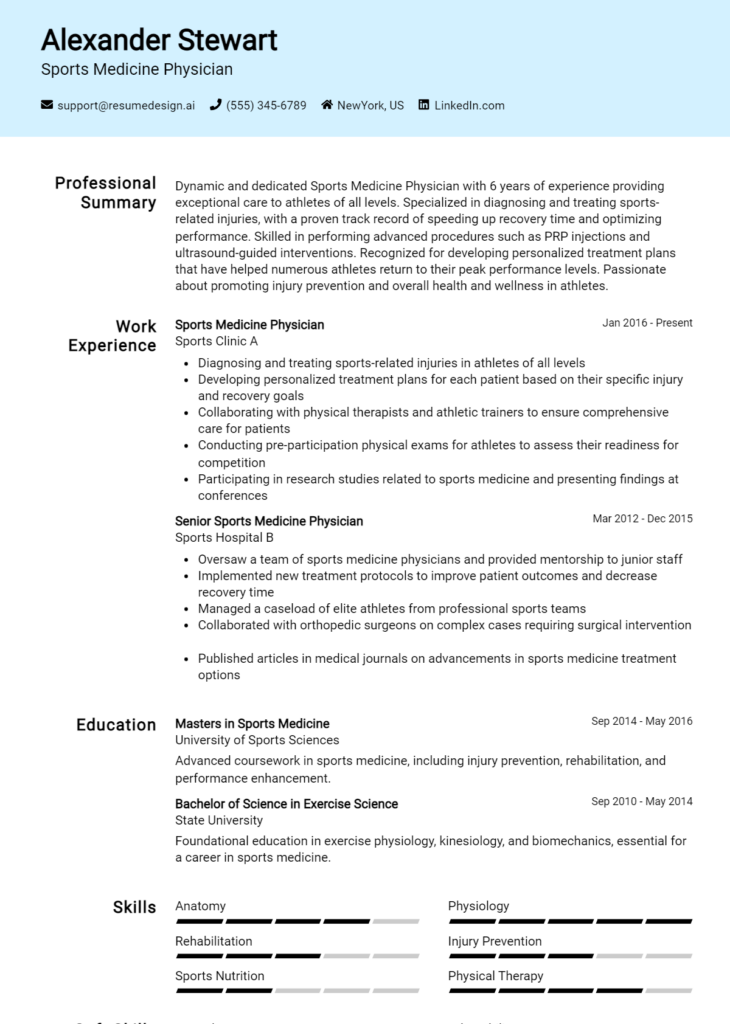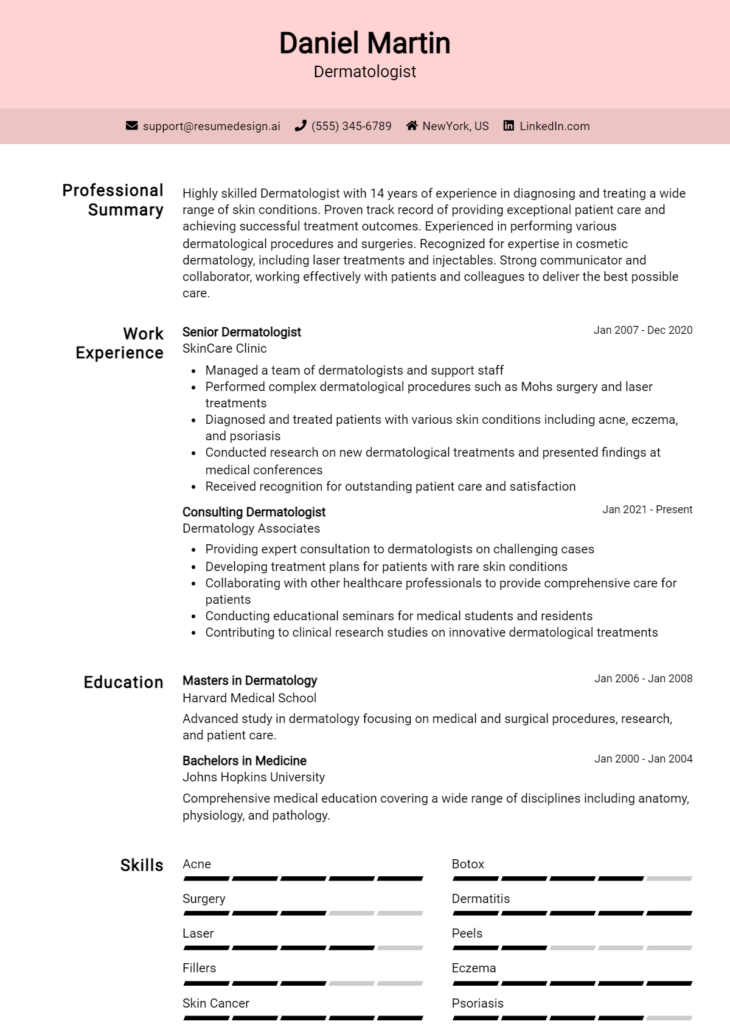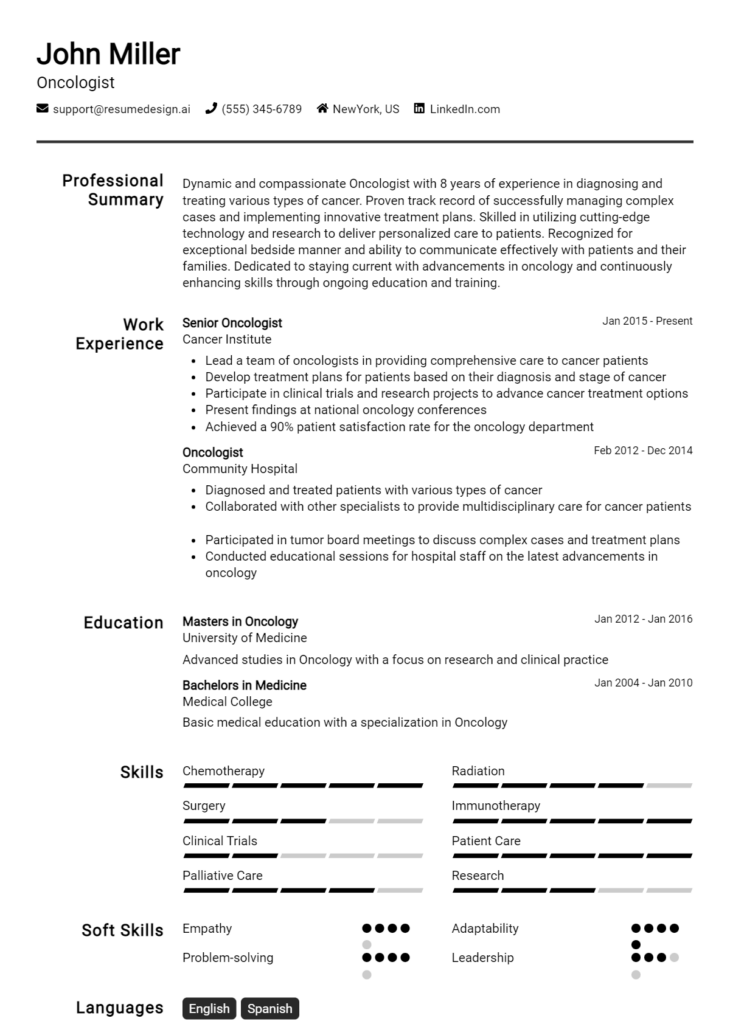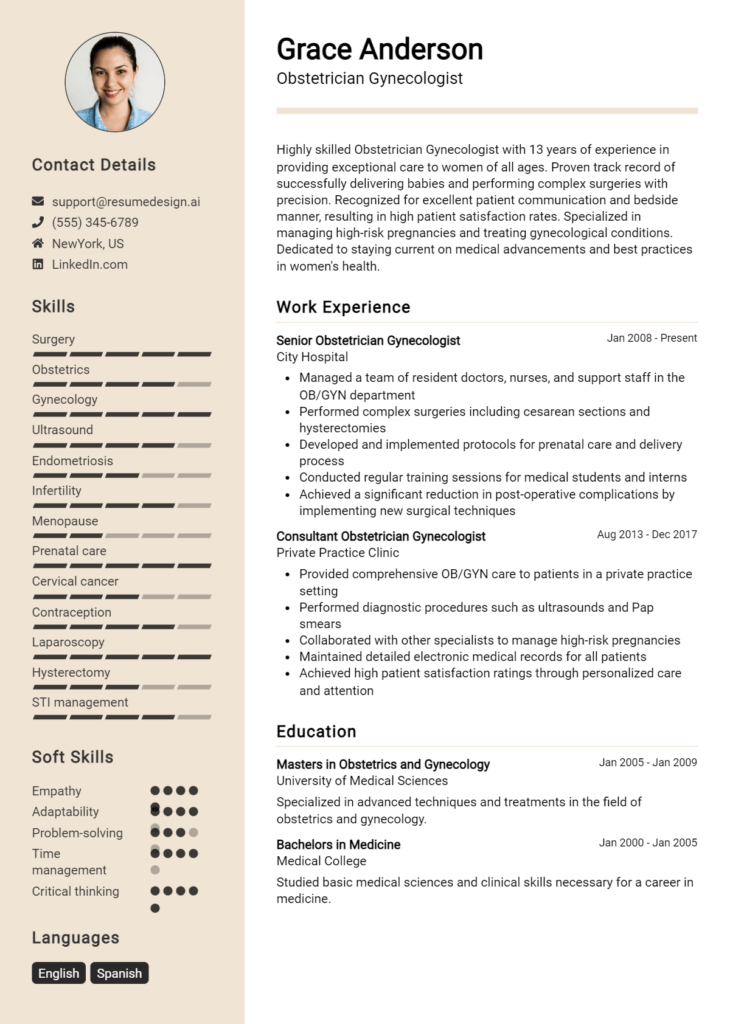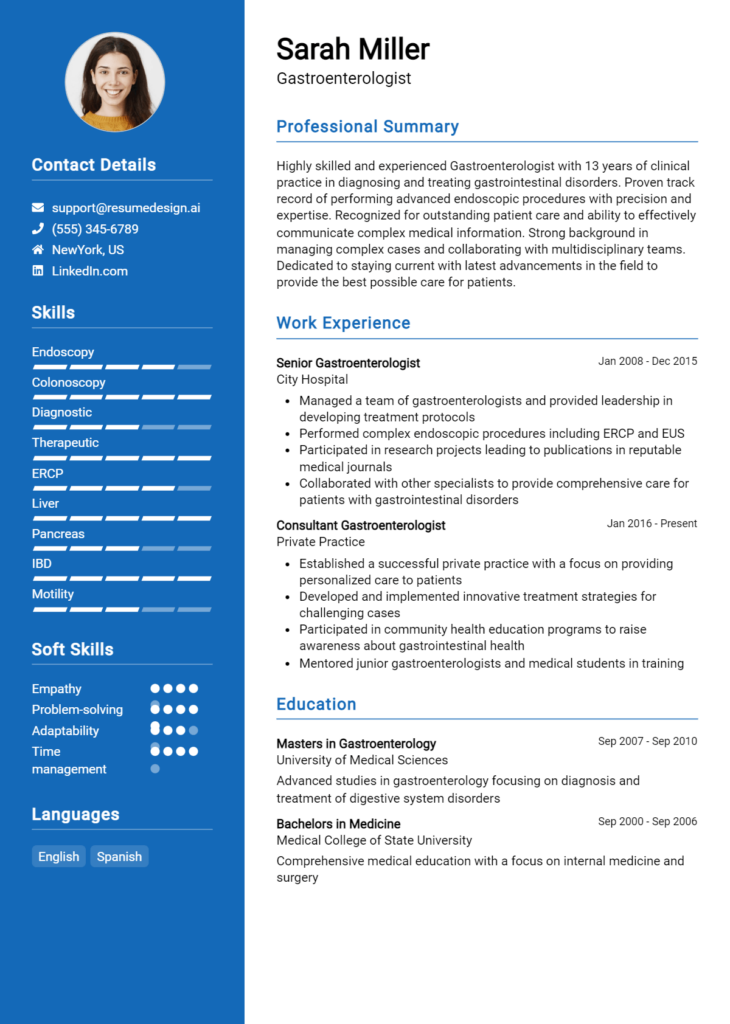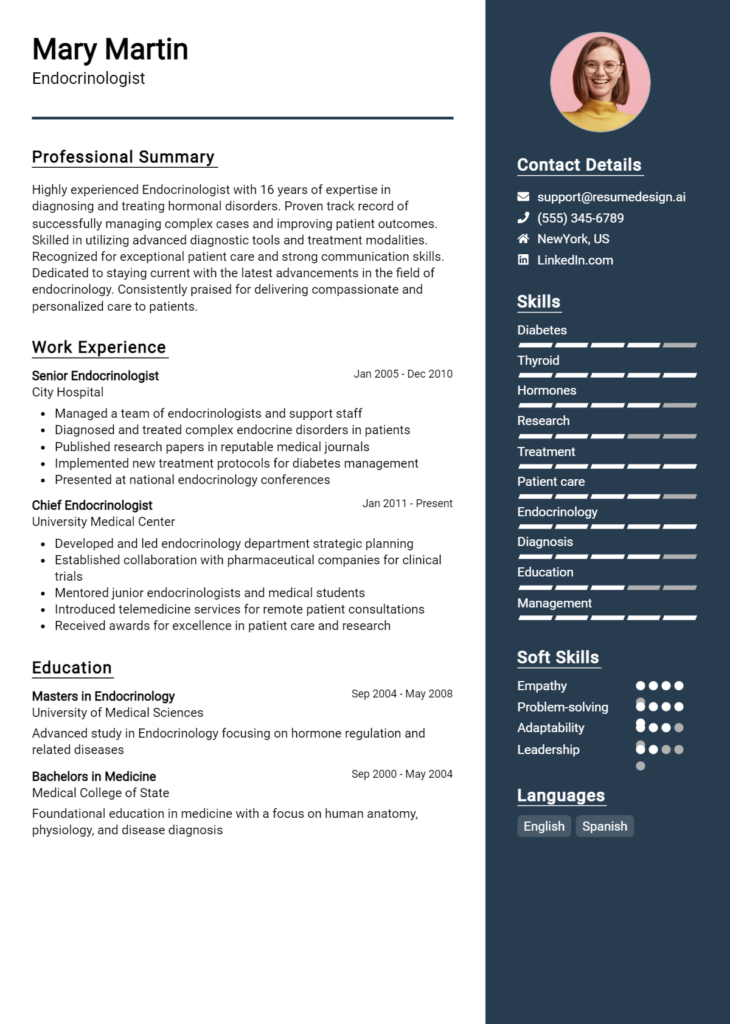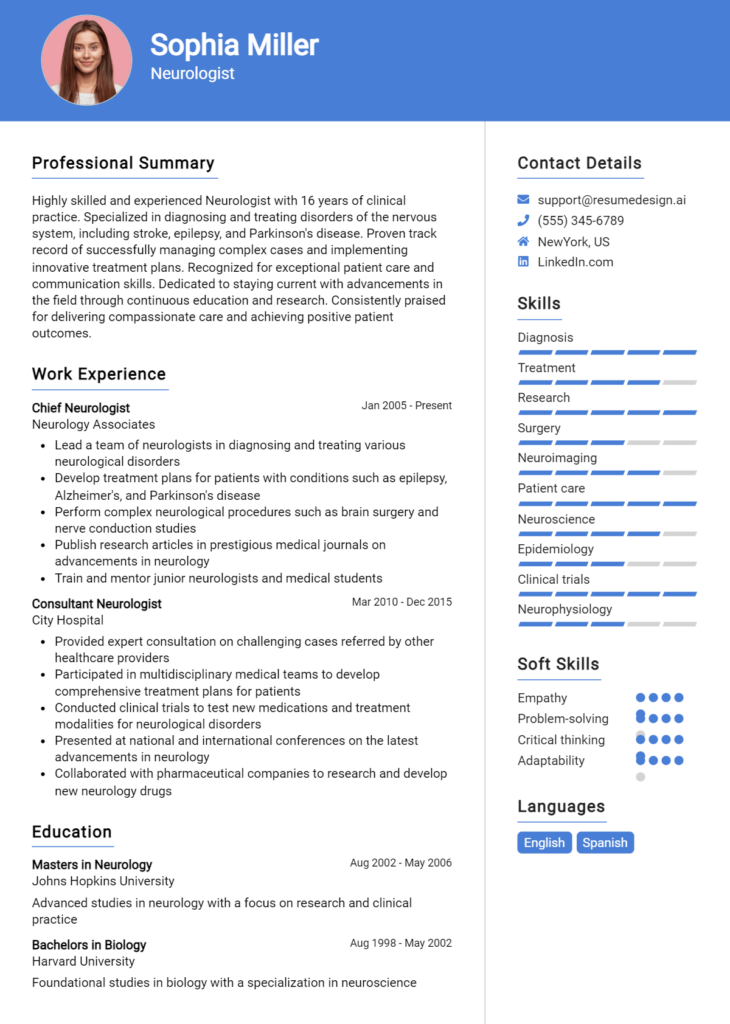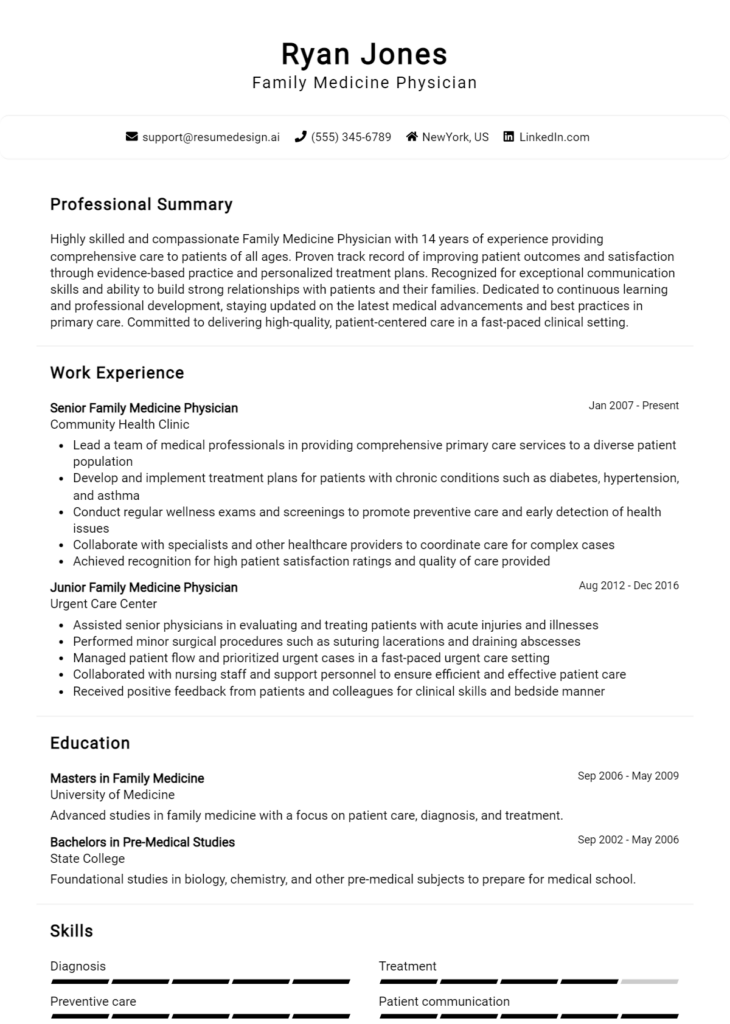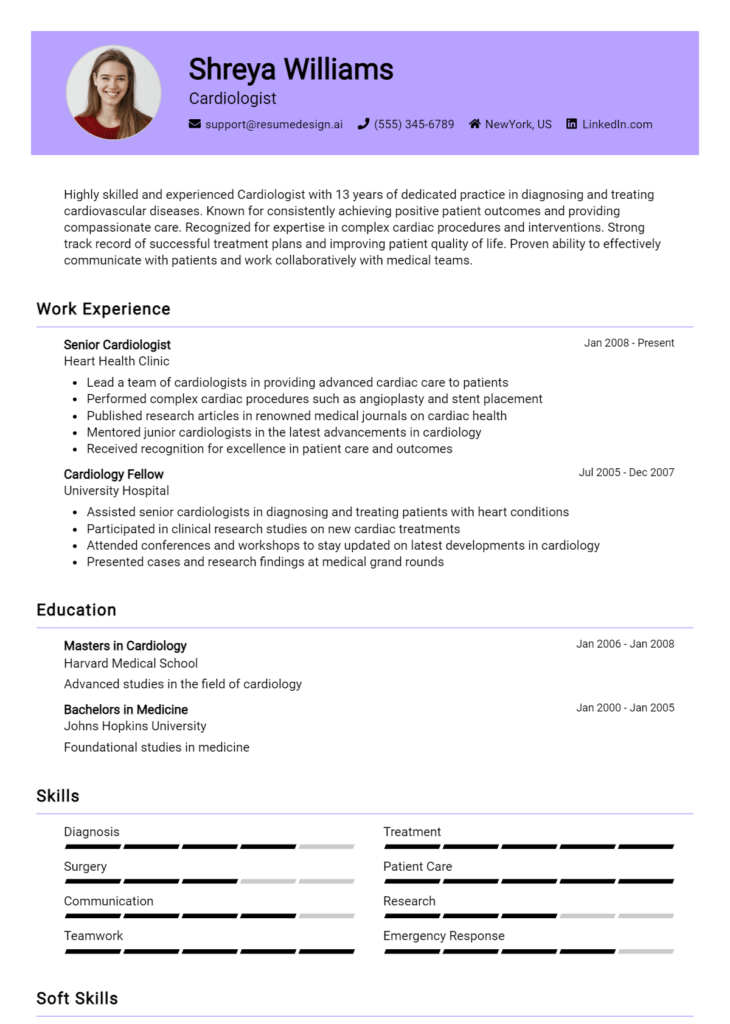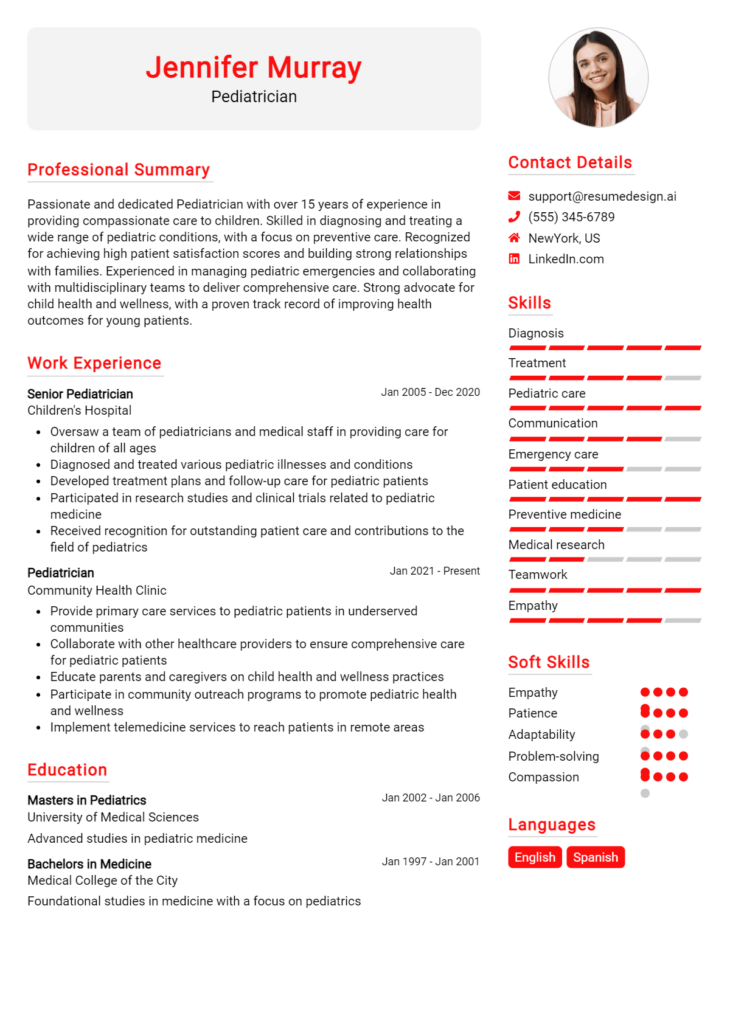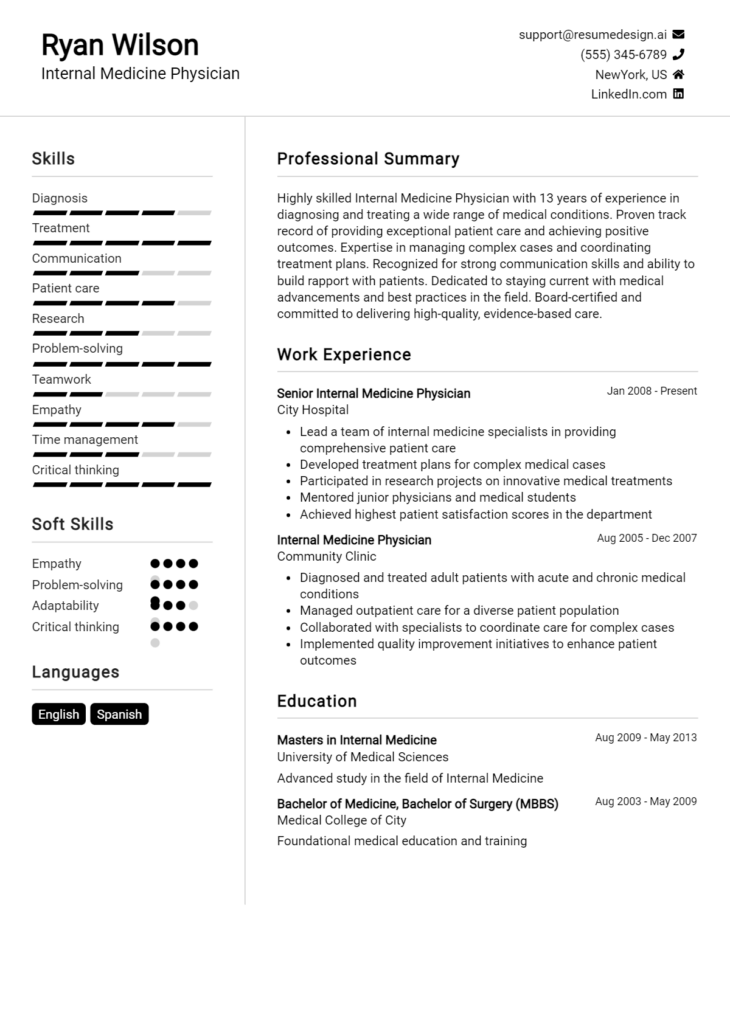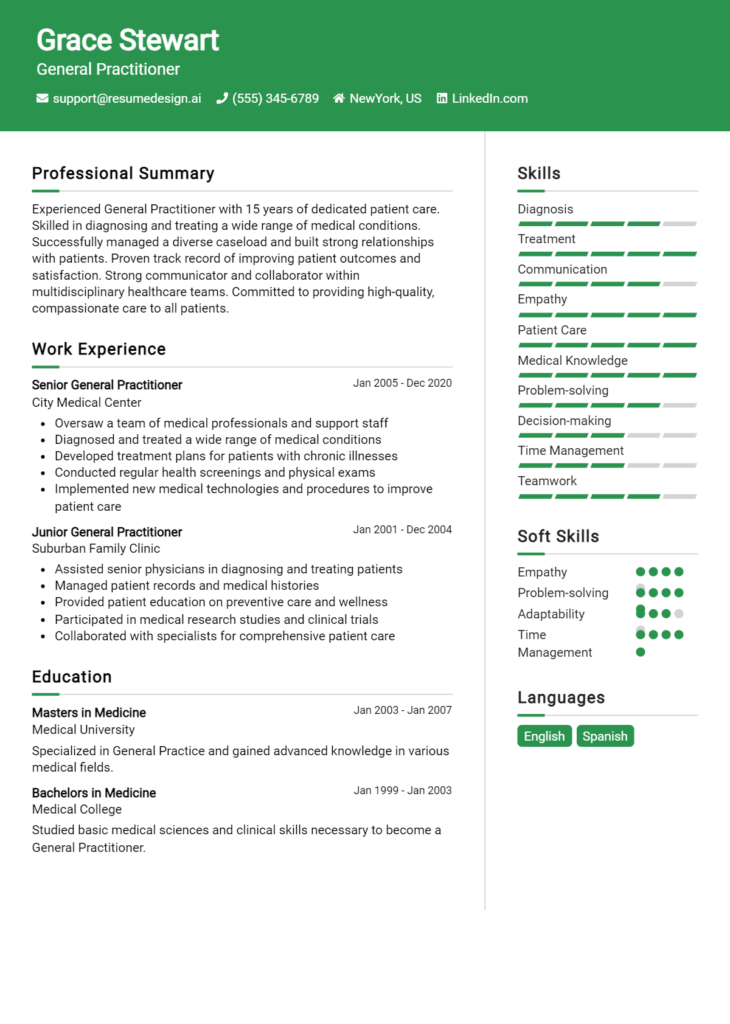Pulmonologist Core Responsibilities
A Pulmonologist specializes in diagnosing and treating respiratory conditions, requiring a blend of technical expertise and problem-solving skills. They collaborate with various departments, including radiology and pathology, to interpret diagnostic tests and develop treatment plans. Effective communication and operational abilities are vital for coordinating patient care and conducting research. These skills not only enhance patient outcomes but also contribute to the organization’s overall mission. A well-structured resume can effectively showcase these qualifications, highlighting a candidate's competencies and experiences.
Common Responsibilities Listed on Pulmonologist Resume
- Conducting comprehensive evaluations of patients with respiratory disorders.
- Performing diagnostic tests such as bronchoscopy and pulmonary function tests.
- Developing individualized treatment plans based on patient assessments.
- Managing chronic respiratory diseases, including asthma and COPD.
- Collaborating with multidisciplinary teams to optimize patient care.
- Educating patients and families about respiratory health and treatment options.
- Conducting research to advance the field of pulmonology.
- Staying updated on the latest advancements in respiratory medicine.
- Participating in quality improvement initiatives within the department.
- Providing consultations for complex cases referred by other specialists.
- Maintaining accurate medical records and documentation.
- Supervising and training residents and medical students in pulmonology.
High-Level Resume Tips for Pulmonologist Professionals
In the competitive field of pulmonology, a well-crafted resume serves as a crucial tool for professionals aiming to make a strong first impression on potential employers. As the initial representation of your skills, experiences, and achievements, your resume must not only catch the eye but also effectively communicate your qualifications in a clear and concise manner. It is essential for pulmonologists to highlight their specialized skills and accomplishments that set them apart from other candidates. This guide will provide practical and actionable resume tips specifically tailored for pulmonologist professionals, ensuring you present yourself in the best light possible.
Top Resume Tips for Pulmonologist Professionals
- Tailor your resume to the specific job description by aligning your skills and experiences with the requirements of the position.
- Highlight relevant clinical experience, including internships, fellowships, and any specialized training in pulmonology.
- Quantify your achievements with statistics and metrics, such as patient outcomes, procedural success rates, or research contributions.
- Include industry-specific skills, such as proficiency in pulmonary function tests, bronchoscopy, and interpreting imaging studies.
- Showcase your involvement in research or clinical trials that demonstrate your commitment to advancing the field.
- Emphasize your certifications and licenses, including board certifications in internal medicine and pulmonology.
- Incorporate patient care philosophies and approaches that reflect your dedication to improving patient outcomes.
- Use clear and concise language, avoiding jargon unless it is commonly understood in the medical field.
- Ensure your resume is visually appealing and easy to read, with consistent formatting and appropriate use of white space.
- Proofread thoroughly to eliminate any errors in spelling or grammar, as attention to detail is crucial in the medical profession.
By implementing these tips, pulmonologists can significantly enhance their resumes, making them more competitive in the job market. A well-structured and targeted resume not only showcases your qualifications effectively but also increases your chances of landing a desirable position in the field of pulmonology.
Why Resume Headlines & Titles are Important for Pulmonologist
In the competitive field of medicine, particularly for specialized roles like a Pulmonologist, having a well-crafted resume headline or title is crucial. A strong headline serves as a powerful introduction that can immediately grab the attention of hiring managers. It encapsulates a candidate's key qualifications and unique selling points in a succinct and impactful manner. A well-thought-out resume title should be concise, relevant, and directly related to the specific job being applied for, setting the stage for the rest of the resume and ensuring that the candidate stands out in a crowded applicant pool.
Best Practices for Crafting Resume Headlines for Pulmonologist
- Keep it concise, ideally under 10 words.
- Make it role-specific, clearly indicating your specialization.
- Incorporate key skills or certifications relevant to the job.
- Use action-oriented language to convey confidence.
- Highlight years of experience or notable achievements.
- Avoid jargon or overly complex terms; aim for clarity.
- Tailor each headline to the specific job application.
- Consider including metrics or quantitative accomplishments where applicable.
Example Resume Headlines for Pulmonologist
Strong Resume Headlines
"Board-Certified Pulmonologist with 10+ Years of Experience"
“Expert in Advanced Pulmonary Disease Management and Critical Care”
“Pulmonology Specialist Focused on Innovative Treatment Solutions”
“Dedicated Pulmonologist Committed to Patient-Centered Care”
Weak Resume Headlines
“Doctor Looking for Job”
“Pulmonologist with Experience”
Strong headlines are effective because they immediately convey the candidate's specialization, experience, and unique value proposition, making them memorable to hiring managers. In contrast, weak headlines lack specificity and fail to communicate the candidate's strengths, making them easily forgettable and less impactful in a competitive job market. A concise and targeted headline can be the difference between capturing interest and being overlooked.
Writing an Exceptional Pulmonologist Resume Summary
A well-crafted resume summary is essential for a Pulmonologist, as it serves as the first impression a candidate makes on hiring managers. This brief overview should effectively encapsulate the candidate's key skills, relevant experience, and notable accomplishments in the field of pulmonology. A strong resume summary not only captures attention quickly but also conveys the candidate's unique qualifications tailored to the specific job they are applying for. It should be concise and impactful, establishing a clear connection between the candidate's expertise and the needs of the employer.
Best Practices for Writing a Pulmonologist Resume Summary
- Quantify Achievements: Use specific numbers and percentages to highlight accomplishments, such as patient outcomes or reductions in hospital readmission rates.
- Focus on Skills: Emphasize both clinical and interpersonal skills that are relevant to pulmonology, including diagnostic abilities, procedural skills, and patient communication.
- Tailor for the Job Description: Customize the summary to align with the specific requirements and responsibilities outlined in the job posting.
- Highlight Specialized Training: Mention any fellowships, certifications, or specialized training that enhance your qualifications in the field.
- Showcase Research and Publications: If applicable, include any relevant research work or publications that demonstrate your expertise and contributions to the field.
- Keep it Concise: Limit the summary to 3-5 sentences to ensure it is easily digestible and impactful.
- Use Active Language: Employ strong, action-oriented verbs to convey your expertise and accomplishments effectively.
- Reflect Your Professional Brand: Ensure that the tone and content of the summary align with your overall professional brand and career goals.
Example Pulmonologist Resume Summaries
Strong Resume Summaries
Board-certified Pulmonologist with over 10 years of experience in diagnosing and treating complex respiratory conditions. Successfully reduced patient readmission rates by 30% through the implementation of comprehensive care plans and patient education initiatives.
Dedicated Pulmonologist specializing in interstitial lung disease, with a proven track record of conducting groundbreaking research published in leading medical journals. Demonstrated ability to improve patient outcomes, achieving a 95% satisfaction rate in post-treatment surveys.
Compassionate and skilled Pulmonologist with extensive experience in critical care settings. Led a multidisciplinary team to enhance care protocols, resulting in a 20% decrease in ICU length of stay for respiratory patients.
Weak Resume Summaries
Experienced doctor with some background in lungs and breathing issues. Looking for a job in a hospital.
Pulmonologist with knowledge in various respiratory diseases. I am seeking a challenging position in a healthcare facility.
The examples above illustrate the difference between strong and weak resume summaries. The strong summaries are specific, quantifiable, and demonstrate a clear alignment with the role's requirements, showcasing the candidate's expertise and achievements. In contrast, the weak summaries lack detail and specificity, making them less compelling and memorable to hiring managers.
Work Experience Section for Pulmonologist Resume
The work experience section of a Pulmonologist resume is a critical component that serves to highlight the candidate's technical skills, management abilities, and commitment to delivering high-quality patient care. This section allows potential employers to assess the depth of experience and expertise the candidate brings to the table, demonstrating their capability to handle complex clinical situations, lead healthcare teams, and implement effective treatment protocols. By quantifying achievements and aligning experiences with industry standards, candidates can effectively showcase their value and differentiate themselves in a competitive job market.
Best Practices for Pulmonologist Work Experience
- Clearly outline specific technical skills relevant to pulmonology, such as advanced ventilation techniques or pulmonary function testing.
- Quantify achievements with metrics, such as patient outcomes, reduction in hospital readmission rates, or successful implementation of new protocols.
- Highlight collaborative projects that demonstrate teamwork, such as multidisciplinary rounds or joint research initiatives.
- Include leadership roles, such as managing a pulmonary care team or spearheading quality improvement initiatives.
- Use action verbs to convey a sense of proactivity and impact, such as "developed," "led," or "optimized."
- Align experiences with current industry standards and guidelines to showcase up-to-date knowledge and practices.
- Provide context for experiences by explaining the challenges faced and how they were overcome.
- Tailor the work experience section to the job description, highlighting the most relevant experiences for each application.
Example Work Experiences for Pulmonologist
Strong Experiences
- Led a multidisciplinary team in the implementation of a new asthma management program, resulting in a 30% reduction in emergency room visits over 12 months.
- Developed and executed a quality improvement project that decreased the average length of stay for COPD patients by 2 days, enhancing patient throughput.
- Published research on the impact of telemedicine on follow-up care for lung disease patients, which informed hospital policy and increased follow-up compliance by 40%.
- Managed a pulmonary rehabilitation program that improved patient exercise tolerance scores by an average of 25%, as measured by standardized tests.
Weak Experiences
- Worked with patients in a clinical setting.
- Assisted in various tasks related to pulmonary care.
- Participated in team meetings to discuss patient care.
- Gained experience in managing respiratory issues.
The examples categorized as strong demonstrate clear, quantifiable outcomes and specific leadership roles that highlight the candidate’s expertise and impact within the field of pulmonology. In contrast, the weak experiences lack detail and measurable achievements, making them less impactful and failing to convey the candidate's true capabilities and contributions. Strong experiences provide a compelling narrative that resonates with potential employers, while weak experiences leave questions about the candidate’s actual skills and effectiveness.
Education and Certifications Section for Pulmonologist Resume
The education and certifications section of a Pulmonologist resume is crucial as it serves to establish the candidate's academic foundation and professional qualifications. This section not only showcases the necessary degrees and licenses required for practicing medicine but also highlights industry-relevant certifications and ongoing education efforts that reflect the candidate's commitment to staying abreast of advancements in pulmonary medicine. By providing detailed information about relevant coursework, specialized training, and recognized credentials, candidates can significantly enhance their credibility and demonstrate their alignment with the specific requirements of the role.
Best Practices for Pulmonologist Education and Certifications
- Include all relevant degrees, such as Doctor of Medicine (MD) or Doctor of Osteopathic Medicine (DO).
- List board certifications, such as the American Board of Internal Medicine (ABIM) certification in Pulmonary Disease.
- Highlight specialized training or fellowships in pulmonary medicine or critical care.
- Incorporate relevant coursework that demonstrates advanced knowledge in areas such as respiratory physiology or pulmonary pathology.
- Update the section regularly to include new certifications or courses completed.
- Use clear and specific language to describe each qualification, avoiding vague terms.
- Prioritize recent and reputable certifications to show current expertise in the field.
- Consider including memberships in professional organizations related to pulmonology.
Example Education and Certifications for Pulmonologist
Strong Examples
- M.D. in Medicine, Harvard Medical School, 2015
- Board Certified in Pulmonary Disease, American Board of Internal Medicine, 2018
- Fellowship in Pulmonary and Critical Care Medicine, Johns Hopkins University, 2019
- Advanced Respiratory Physiology Coursework, University of California, San Francisco, 2020
Weak Examples
- Bachelor of Arts in Psychology, University of XYZ, 2012
- Certification in Reiki Therapy, 2016
- Outdated Basic Life Support certification from 2013
- General Medical License without specialization in Pulmonology, 2017
The strong examples are considered effective because they align directly with the requirements of a Pulmonologist, showcasing relevant medical degrees, board certifications, and specialized training that highlight the candidate's qualifications. In contrast, the weak examples lack relevance to the field of pulmonology, including outdated certifications and unrelated degrees, which do not support the candidate's expertise in respiratory medicine.
Top Skills & Keywords for Pulmonologist Resume
As a pulmonologist, the ability to effectively diagnose and treat respiratory conditions is paramount. However, showcasing the right skills on a resume can significantly enhance a candidate's appeal to potential employers. A well-crafted resume highlights both hard and soft skills that are essential for success in this specialized field. Hard skills demonstrate the technical proficiency and medical knowledge necessary to perform procedures and interpret diagnostic tests, while soft skills reflect the ability to communicate effectively, empathize with patients, and work collaboratively within a healthcare team. Together, these skills create a comprehensive profile that can set a pulmonologist apart in a competitive job market.
Top Hard & Soft Skills for Pulmonologist
Soft Skills
- Strong communication skills
- Empathy and compassion
- Team collaboration
- Problem-solving abilities
- Attention to detail
- Time management
- Adaptability
- Critical thinking
- Active listening
- Patient education
Hard Skills
- Proficiency in pulmonary function testing
- Knowledge of sleep medicine
- Expertise in bronchoscopy
- Familiarity with advanced imaging techniques (CT, MRI)
- Interpretation of chest X-rays
- Experience with respiratory therapy techniques
- Skills in managing ventilators
- Understanding of pharmacology related to respiratory care
- Ability to perform thoracentesis
- Proficiency in electronic health record (EHR) systems
For more guidance on developing your resume, explore this comprehensive skills section and consider how to effectively present your work experience alongside these essential skills.
Stand Out with a Winning Pulmonologist Cover Letter
Dear Hiring Manager,
I am writing to express my interest in the Pulmonologist position at [Hospital/Clinic Name], as advertised on [Job Board/Website]. With over [X years] of specialized experience in diagnosing and treating respiratory disorders, combined with a passion for improving patient outcomes, I am excited about the opportunity to contribute to your esteemed healthcare team. My extensive training in pulmonary medicine, coupled with my commitment to compassionate patient care, aligns perfectly with the values and mission of [Hospital/Clinic Name].
Throughout my career, I have honed my skills in managing a diverse range of pulmonary conditions, including chronic obstructive pulmonary disease (COPD), asthma, and interstitial lung disease. My experience in conducting advanced diagnostic procedures, such as bronchoscopy and pulmonary function tests, has equipped me with the expertise to develop effective treatment plans tailored to individual patient needs. At [Previous Institution/Practice Name], I successfully led initiatives aimed at enhancing patient education and adherence to therapies, resulting in improved health outcomes and reduced hospital readmission rates.
I am particularly drawn to [Hospital/Clinic Name] due to its reputation for excellence in patient care and its commitment to innovative research in pulmonary medicine. I am eager to collaborate with your multidisciplinary team to further advance the quality of care provided to patients suffering from respiratory illnesses. I am confident that my clinical skills, along with my dedication to continuous learning and professional development, will make a positive impact on your institution and the community it serves.
Thank you for considering my application. I am looking forward to the opportunity to discuss how my background, skills, and enthusiasms align with the needs of your team. I am eager to bring my expertise to [Hospital/Clinic Name] and contribute to your mission of delivering outstanding patient care.
Sincerely,
[Your Name]
[Your Contact Information]
Common Mistakes to Avoid in a Pulmonologist Resume
Crafting a resume as a pulmonologist requires attention to detail and a clear presentation of your qualifications and experience. However, many candidates make common mistakes that can hinder their chances of securing an interview. Avoiding these pitfalls ensures that your resume stands out for the right reasons and effectively showcases your expertise in the field of pulmonary medicine.
Ignoring Keywords: Failing to include relevant keywords from the job description can result in your resume being overlooked by applicant tracking systems (ATS). Tailor your resume to match the specific language used in the job listing.
Lack of Specificity: Vague descriptions of your experience can leave hiring managers confused. Be specific about your clinical responsibilities, patient outcomes, and procedures you’ve performed to demonstrate your competencies.
Overloading with Jargon: While medical terminology is essential, overloading your resume with jargon can alienate non-medical readers. Strike a balance between professional language and readability.
Neglecting Continuing Education: In a field that constantly evolves, failing to highlight your ongoing education and training can make you appear stagnant. Include relevant certifications, workshops, and conferences you’ve attended.
Underestimating Soft Skills: While technical skills are crucial, soft skills such as communication, teamwork, and empathy are equally important in patient care. Make sure to include examples of these skills in your resume.
Using a Generic Format: A one-size-fits-all resume can dilute your personal brand. Customize your format to reflect your unique experiences, and ensure that it is visually appealing and easy to navigate.
Omitting Research Experience: If applicable, neglecting to mention any research or academic contributions can be a missed opportunity. Highlight any studies, publications, or presentations that showcase your expertise and commitment to advancing the field.
Inconsistent Formatting: Inconsistencies in font, size, or bullet points can distract from the content of your resume. Ensure that your formatting is uniform throughout for a polished and professional appearance.
Conclusion
As a pulmonologist, your expertise in diagnosing and treating respiratory conditions is critical to improving patients' quality of life. In this article, we explored the various responsibilities of a pulmonologist, including conducting patient evaluations, interpreting diagnostic tests, and providing comprehensive treatment plans. We also highlighted the importance of staying updated with the latest advancements in pulmonary medicine and the need for effective communication skills to collaborate with other healthcare professionals.
To ensure that you stand out in the competitive field of pulmonary medicine, it is essential to have a polished and professional resume that showcases your education, experiences, and skills effectively. We encourage you to review your pulmonologist resume and consider utilizing various tools to enhance it.
Make use of resume templates to create a visually appealing format that highlights your qualifications. You can also explore the resume builder for a streamlined approach to crafting your resume. If you need inspiration, check out the resume examples that can give you ideas on how to structure your own. Additionally, don’t forget the importance of an engaging introduction; our cover letter templates can help you create a compelling cover letter that complements your resume.
Take action today—revamp your resume and position yourself for success in your career as a pulmonologist!

